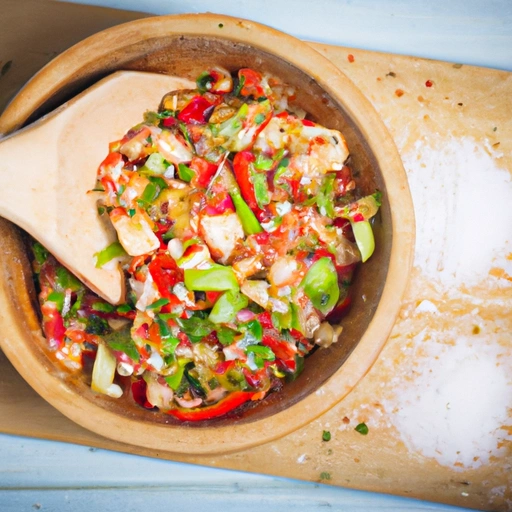Sofrito
Description

Sofrito is a flavorful blend of finely chopped vegetables, herbs, and sometimes cured meats, that is sautéed in oil and used as a foundational component in many culinary traditions. Typically composed of ingredients like onions, garlic, peppers, and tomatoes, sofrito varies by region and can include an array of spices and additional elements. The ingredients in a sofrito are often cooked slowly to meld and intensify their flavors, creating a rich base that can deepen the taste of soups, stews, sauces, and more. This vibrant mixture is not only a staple in the kitchen but also an embodiment of cultural heritage and culinary creativity.
Common uses
Sofrito is used as a flavor enhancer in a myriad of dishes. It's often the starting point for soups, stews, rice dishes, sauces, and braises. Depending on the cuisine, it might be called by different names, such as 'soffritto' in Italy or 'refogado' in Portuguese-speaking countries. The versatility of sofrito allows it to be adapted for vegetarian and meat-based dishes alike, and it can be customized with additional ingredients like cilantro, bell peppers, or ham to suit the cook's preference or the requirements of a specific recipe.
Nutritional value
Calories
Calories in sofrito can vary based on the ingredients and the amount of oil used. However, a rough estimate for a 1/4 cup (about 59 ml) serving is approximately 20-30 calories.
Protein
Sofrito is not a significant source of protein, as it is primarily made of vegetables and used in small amounts to flavor dishes.
Fat
The fat content in sofrito will largely depend on the type and quantity of oil used in the preparation. Olive oil is a common choice, contributing to the overall healthfulness of the dish.
Carbohydrates
Carbohydrates in sofrito come mainly from the vegetables used. A 1/4 cup serving may contain around 3-5 grams of carbohydrates.
Vitamins
Vegetables like tomatoes, peppers, and onions in sofrito provide vitamins such as vitamin C, vitamin A, and various B vitamins, contributing to a balanced diet.
Minerals
Sofrito also contains minerals such as potassium and magnesium, which are essential for maintaining good health.
Health benefits
As a medley of vegetables, sofrito is rich in vitamins and antioxidants which can support immune function, reduce inflammation, and might contribute to a reduced risk of chronic diseases. The olive oil commonly used is a source of monounsaturated fats, beneficial for heart health.
Potential risks
The primary risk associated with sofrito arises from the oil used in its preparation, which can increase the calorie and fat content of dishes. However, when used in moderation and with heart-healthy oils, it can be part of a balanced diet.
Common recipes
Sofrito is a key ingredient in recipes like paella, gumbo, and various pasta sauces. It's also used to season beans, lentils, and meat dishes, providing depth and complexity to the flavors.
Cooking methods
The cooking method for sofrito typically involves sautéing the chopped vegetables and herbs in oil over low heat, allowing the flavors to concentrate and blend harmoniously.
Pairing with other ingredients
Sofrito pairs well with grains like rice and quinoa, proteins such as chicken, beef, and seafood, and it can be added to vegetable dishes for an extra layer of flavor.
Summary
Sofrito serves as a versatile aromatic base that underpins the flavor profile of countless dishes around the world. Its simple yet profound composition can be adapted to suit various cuisines and dietary preferences, making it a cherished ingredient in kitchens across the globe. As a fusion of vegetables and sometimes meats, it encapsulates the essence of many regional cooking traditions and continues to inspire contemporary interpretations of classic recipes.